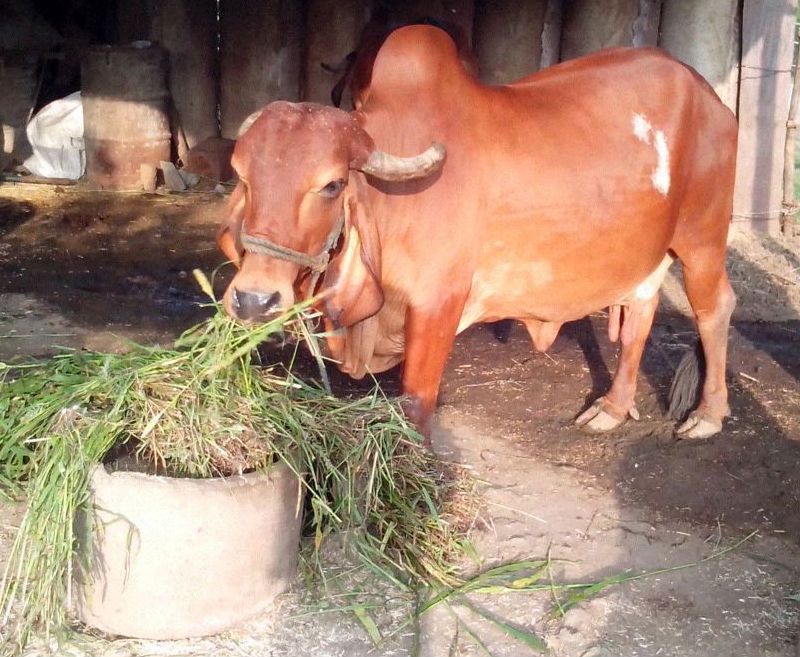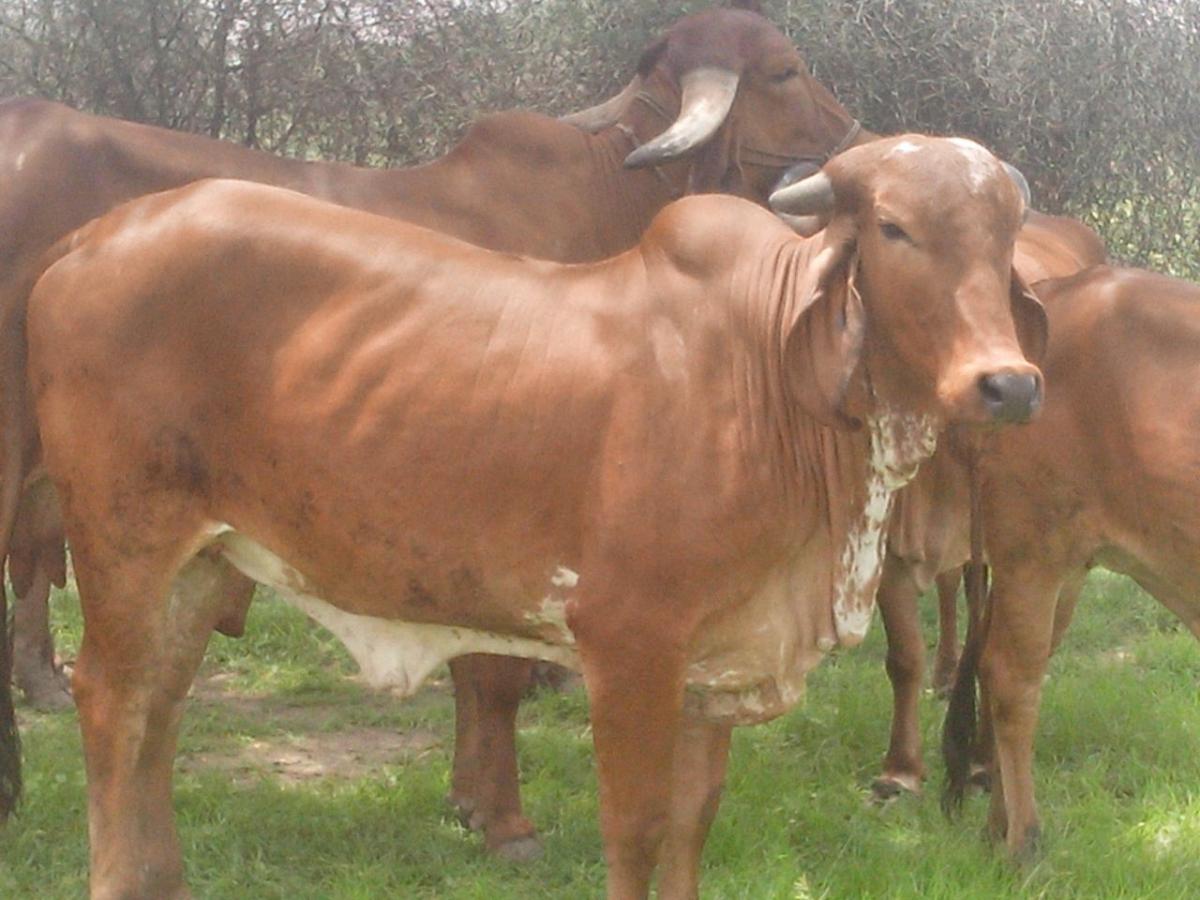Gir Cow Features


Gir
Head
The most unique feature of Girs is their convex forehead, which acts as a cooling radiator to the brain and pituitary gland (source of growth and reproduction hormones). The animals have a big head with prominent bulging shield like forehead and a long face.
Ears
Their ears are long and pendulous, opening to the front and resembling a curled up leaf. Gir ears are very large and are an excellent fly and insect swatter.
Horns
Horns are set well back on their heads and thick at the base. They grow downwards and backwards with an upward curve.
Color
The vary in color from pure red to speckles, yellowish red to white with large red spots. Their undercoat is red.
Color
The vary in color from pure red to speckles, yellowish red to white with large red spots. Their undercoat is red.
Skin
Their skin is darkly pigmented with short glossy hair, very loose and pliable. They can twitch it anywhere on their body to dislodge insects and have a whip like tail, which is deadly on insects. They sweat just like a horse
Eyes
A Gir’s eyes are hooded and black pigmented. They can close their eyelids so it is impossible for insects to annoy them. They have a lot of loose skin around the eye area.
Feet
Gir’s feet are black and very hard.
Sheath
The sheath is supported by a very strong panniculus muscle either side. The muscle can raise and lower the sheath at will. Sheaths are very neat and tidy.
Sebum
Is a substance secreted in the skin, which is greasy and acts as an insect repellent.
Fertility
Girs are highly fertile and calve very regularly. Their calves are born small so calving problems are unheard of.
Hump
The hump on a Gir is considered to be the largest of the Zebu breeds and is very well marbled. It is used as a pot roast
Temperament
Girs are considered to be the most gentle of the Zebu breeds. They love being with humans. They adore being brushed and scratched on their big dew laps, around the head, and between the back legs. Their temperament is well illustrated in Brasil where the cow will come into bails to be milked by machines just like any Friesian or Jersey cow. They are very gregarious and at night form a circle very close together with their calves sleeping under their necks. Gir cattle are one of the three Zebu breeds used to develop the American Brahman. Two of the most famous foundation sires, Manso and Emperor, carried a high Gir content. This can be seen in their down swept horns, big humps, straight wide backs, and beautifully sloping, filled out hind quarters.
The Gir or Gyr is one of the principal Zebu breeds originating in India. It has been used locally in the improvement of other breeds including the Red Sindhi and the Sahiwal. It was also one of the breeds used in the development of the Brahman breed in North America. In Brazil and other South American countries the Gir is used frequently because, as a Bos indicus breed, it is resistant to hot temperatures and tropical diseases. It is very known for its milk producing qualities and is often bred with Friesian cows to make theGirolando breed. The Gir is distinctive in appearance, typically having a rounded and domed forehead (being the only ultra convex breed in the world), long pendulous ears and horns which spiral out and back. Gir are generally mottled with the color ranging from red through yellow to white, black being the only unacceptable color. They originated in southwest India in the state of Gujarat and have since spread to neighboring Maharashtra and Rajasthan. Actually the name is GIR & not GYR as misspelled by some of the people, GIR is a place famous for last abode of Asiatic lions, the place is situated about 45 kilo meters from the district headquarters of Junagadh, in Gujarat state of India. The breed was kept by local people known as Maldhari for their livelihood. The breed is known for its distinct appearance, height & weight and natural beauty which makes it very different from the Jersey cows etc. The breed is today on the verge of extinction from India as people of India are using more of buffalo milk then the cow's milk. (The breed is on verge on extinction due to lack to breeding programs and irrational crossbreeding with breeds more common to western nations.) Finding it economically difficult for the people to keep a gaay in their herd. Today however due to efforts of social activist Mr. Mansukhbhai Suvagiya (a farmer turned industrialist and a revolutionary visionary from small village of Junagadh District) the awareness is created among people of Gujarat about saving this real pride breed of Gujarat. Mr. Mansukhbhai Suvagiya along with his other friends have started a plan of breeding 10,00,000 high quality gir gaay in Gujarat to regain the lost grounds.For this noble cause a trust has been formed in rajkot known as Jalkranti Trust. The trust as of now carries out two main activities of Gir Gaay Breeding and Water conservation. The efforts of this man & his team have started showing results in terms of increase in the no. of gir gaay and increase in the general awareness of People. Many of the Swaminarayan Temples have also helped in preserving this high quality breed from Gujarat, which includes Charodi Swaminarayan gurukul at Ahmedabad,Bhuwneshwari pith gondal in the sate of Rajkot,Sagwadi Education & gaushala Charitable trust at Bhavnagar etc. High quality gir gaay are available in the district of Junagadh, Bhavnagar, amreli, and Rajkot in the state of Gujarat.
Body Size
The origin of the breed is in the Gir forest region and surrounding districts of Saurashtra region of Gujarat State. It is a moderate to large size breed. The females average 385 kg with a height of 130 cm and the males average 545 kg with a height of 135 cm. The average milk yield for the Gir is 1590 kg per lactation, with a record production of 3182 kg at 4.5% fat in India. In Brazil they average 3500 kg per lactation, with a world record production of 17.120 kg by the cow Profana de Brasília. The body colour is shining red to spotted white. Skin is soft, thin, and glossy. Occasionally animals which are predominantly white with red spots are also seen, according to Dr. J. V. Solanki, Dean, Veterinary College, Anand Agricultural University (AAU), Anand, Gujarat.


Gir Cow
